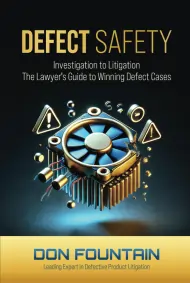The Week In Torts – Cases from December 23, 2022

What DID you mean?
FLORIDA LAW WEEKLY
VOLUME 47, NUMBER 51
CASES FROM THE WEEK DECEMBER 23, 2022
AMBIGUITIES WITHIN THE PRETRIAL STIPULATIONS ENTERED INTO BY THE PARTIES RENDERED THE TRIAL COURT’S DECISION TO ALLOW THE PARTIES TO ARGUE THEIR BELIEVED RESPECTIVE MEETINGS OF WHAT THOSE STIPULATIONS MEANT, REASONABLE
Jones v. Blue Ridge Manufacturing, 47 Fla. L. Weekly D2628 (Fla. 4th DCA Dec. 14, 2022):
The plaintiff had conceded that the decedent caused the subject accident, when he drove his Mercedes into the back of a stationary Ford F-550 that weighed six times as much as the Mercedes, and was hauling granite slabs at the time. Plaintiff believed that the decedent’s death was caused in part by the truck’s failed “underride guard;” a device meant to keep a car from sliding under the bed of a large truck in the event of an accident.
The parties had entered into several pretrial stipulations. Two of them reflected agreement that the decedent’s fatal injury was a transverse basal skull fracture which caused the fatal concussion due to direct or indirect contact with the flatbed of the Ford F-550. The parties also agreed that the decedent sustained a right sided mandibular fracture as a result of direct or indirect contact with the flatbed of the Ford F-550.
Despite these stipulations, the defendant later disagreed as to the meaning of “direct or indirect contact” as used in the stipulation, even though its own expert had defined it as the plaintiff believed.
The court explained that courts are to interpret pretrial stipulations using the same principles used for interpreting written contracts, and that there must be a meeting of the minds for enforcement of the stipulation.
Because the phrases found in the stipulation were capable of more than one reasonable meaning, the court concluded that the stipulations were ambiguous, and found that the trial court had not abused its discretion in allowing the matter to be submitted to the finder of fact accompanied by extrinsic evidence to explain the meaning of them.
APARTMENT COMPLEX OWED NO DUTY TO WARN OF AN OPEN AND OBVIOUS SPEED BUMP THE PLAINTIFF KNEW ABOUT
Smith v. Westdale Asset Management, 47 Fla. L. Weekly D2620 (Fla. 1st DCA Dec. 12, 2022):
The plaintiff was helping a friend of hers move out of her apartment, when she tripped over a speed bump as she headed to the bank of mailboxes. The plaintiff asserted that the unpainted speed bump had been partly concealed by the shade of a tree, and she did not see it. However, she also acknowledged that she was not looking ahead while walking on the roadway because she was searching for the mailboxes. The plaintiff sued alleging that the defendant breached its duty to warn of the dangerous condition and that it had negligently maintained its premises.
In a premises liability case, a plaintiff must demonstrate that the defendant had actual or constructive knowledge of the dangerous condition on the premises, that the defendant owed a duty to protect the plaintiff from the dangerous condition, and that the defendant breached this duty which caused the plaintiff to fall.
The court agreed with the trial judge that the presence of the speed bump was open and obvious, and specifically known to the plaintiff, as the plaintiff testified she had driven over those speed bumps at least three times in the past year. Property owners generally owe no duty to warn an invitee of an open and obvious condition.
Additionally, the defendant did not breach a duty to exercise ordinary care to maintain its premises in a reasonably safe condition. The record did not indicate that the speed bump was an inherently dangerous condition which would cause injury, but even if it were, it was so open and obvious that the plaintiff could not have reasonably have expected to have been warned of that danger.
The court concluded that the defendant could not have reasonably anticipated that the plaintiff would have disregarded the speed bump, before falling and injuring herself, and thus affirmed the entry of summary judgment.
Judge Makar dissented, finding that a jury issue existed as to the visibility of the unmarked speed bump that the plaintiff tripped over, and disagreeing that the summary judgment was appropriate.
NO ERROR IN GRANTING SUMMARY JUDGMENT IN FAVOR OF DEFENDANT OWNER OF A TRAILER BEING PULLED BY A TRACTOR, WHERE THE DEFENDANT SUBMITTED UNCONTROVERTED EVIDENCE THAT IT DID NOT OWN THE TRACTOR – A TRAILER ITSELF IS NOT A DANGEROUS INSTRUMENTALITY
Saunders-Pinnock v. Colonial Freight Systems, Inc., 47 Fla. L. Weekly D2642 (Fla. 3rd DCA Dec. 14, 2022):
A tractor trailer collided with plaintiff’s vehicle and ran. The plaintiff later tracked down the trailer owner, and sued Colonial Freight.
Colonial Freight moved for summary judgment. While the plaintiff had photographs suggesting that Colonial Freight was the owner of the trailer (partial lettering), Colonial Freight submitted uncontroverted evidence that no Colonial Freight driver or tractor had been in the vicinity of the accident at the time and place it occurred.
Because the plaintiff could not produce any evidence as to the ownership of the trailer, the trial court appropriately granted summary judgment (the law says that while a “tractor” is a dangerous instrumentality, the trailer itself is not).
TRIAL COURT DEPARTED FROM ESSENTIAL REQUIREMENTS OF LAW IN DENYING DEFENDANT’S MOTION TO DISMISS IN THIS MED MAL CASE, ALLEGING THAT PLAINTIFF FAILED TO COMPLY WITH STATUTORY PRESUIT REQUIREMENTS, WITHOUT MAKING EXPRESS FINDINGS AS TO WHETHER THE PLAINTIFF HAD COMPLIED WITH THEM
Adventist Health System v. Machlalek, 47 Fla. L. Weekly D2653 (Fla. 5th DCA Dec. 16, 2022):
A trial court departs from the essential requirements of the law, thus justifying certiorari relief, when it denies a defendant’s motion to dismiss the plaintiff’s medical malpractice action, without making “express findings” as to whether the plaintiff complied with the statutory presuit requirements.
Here, the trial court entered orders denying the respective motions to dismiss. However, the Orders were silent on the reasons for the denial.
The court granted the petition for writ and remanded for the trial court to make the requisite express findings as to whether the plaintiff complied with Chapter 766’s presuit requirements.


